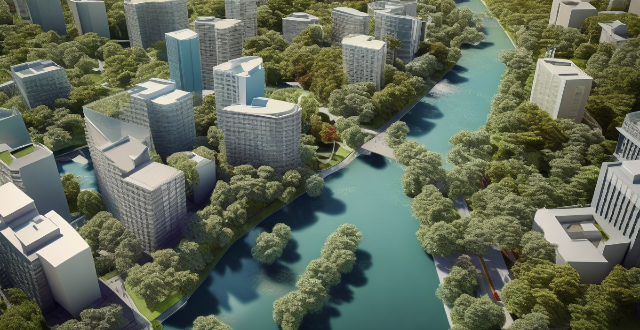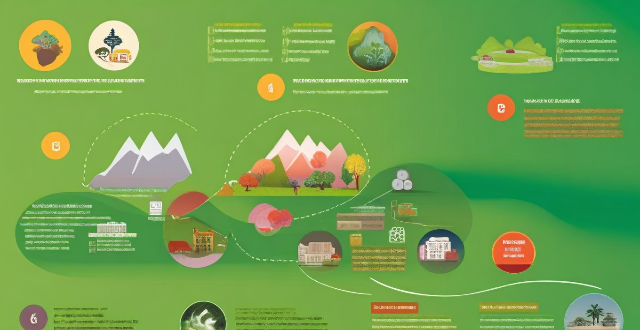Vulnerable Infrastructure

How do climate change negotiations address the needs of vulnerable communities ?
Climate change disproportionately affects vulnerable communities, such as those living in poverty or low-lying coastal areas. It is crucial for climate change negotiations to address their needs and ensure that they are not left behind in the fight against climate change. This involves recognizing the impact of climate change on these communities, incorporating vulnerability into climate change negotiations, providing access to information and participation in decision-making processes, offering financial and technical support for adaptation measures, ensuring just transitions away from high-emission industries, and promoting resilience and sustainable development. By doing so, vulnerable communities can become more resilient to future climate change impacts and contribute to a more equitable and sustainable world.

How does climate vulnerability differ across regions and countries ?
Climate vulnerability varies significantly across regions and countries due to geographical, socio-economic, infrastructure, governance, and cultural factors. Coastal areas are more vulnerable to rising sea levels, while inland areas face challenges related to droughts and heatwaves. Developed nations have more resources for adaptation, while developing nations often lack the financial and technical capacity. Urban areas might have better access to resources but can suffer from heat island effects, while rural areas could be impacted by changes in agricultural productivity. Areas with robust infrastructure and advanced technologies are less vulnerable, while those lacking these face higher risks. Stable governments can develop long-term climate policies, while unstable regions might lack the continuity needed for effective climate action. Communities with strong social networks and high levels of education about climate change are more likely to engage in adaptive behaviors. Addressing climate vulnerability requires tailored approaches that consider each area's unique circumstances and needs.

How do climate and environmental policies address the needs of vulnerable communities and ecosystems ?
Climate and environmental policies are essential for addressing the needs of vulnerable communities and ecosystems. These policies aim to reduce emissions and pollution, protect natural resources, build resilience and adaptation capacity, and promote environmental justice. By implementing measures such as promoting renewable energy sources, establishing protected areas, providing funding for climate adaptation projects, and ensuring equitable access to clean energy technologies, these policies can significantly improve the health and quality of life for vulnerable communities while also contributing to global efforts to combat climate change.

How can we involve vulnerable communities in climate action planning and implementation ?
Involving vulnerable communities in climate action planning and implementation is crucial for creating effective, equitable, and sustainable solutions to the climate crisis. Here's how we can ensure their involvement: 1. Identify and engage with vulnerable communities through community meetings, workshops, and consultations. 2. Build trust and capacity within these communities by involving them in decision-making processes, providing regular updates on progress, demonstrating transparency and accountability, and offering training programs on climate change science, policy advocacy, and project management skills. 3. Collaborate with vulnerable communities to develop solutions that address their specific needs and priorities while being culturally sensitive and respectful of local traditions and practices. 4. Regularly monitor progress towards climate action goals and evaluate the impact of initiatives on vulnerable communities by collecting data on changes in environmental conditions, economic opportunities, and social wellbeing, as well as seeking feedback from community members.

How can climate finance be made more equitable and accessible to vulnerable communities ?
Climate finance plays a crucial role in addressing the challenges posed by climate change. However, ensuring that this finance is equitable and accessible to vulnerable communities requires a multi-faceted approach. Here are some strategies that can be employed: 1. Prioritize Vulnerable Communities: Identify and target vulnerable communities, allocate adequate resources, develop targeted programs and initiatives that address their needs. 2. Enhance Capacity Building: Provide training and education on climate change mitigation and adaptation strategies tailored to the needs of vulnerable communities, build institutional capacity, strengthen partnerships between governments, civil society organizations, and community groups to ensure coordinated efforts in capacity building. 3. Promote Participatory Approaches: Encourage community participation in the design, implementation, and monitoring of climate finance projects, enhance transparency and accountability, hold stakeholders accountable for meeting agreed-upon targets and milestones related to climate finance distribution and utilization. 4. Leverage Technology and Innovation: Utilize digital platforms where vulnerable communities can access information about available climate finance opportunities and apply for funding, use mobile technology to reach remote areas and provide real-time updates on project progress and outcomes, encourage innovative solutions that address the unique challenges faced by vulnerable communities, support research and development initiatives focused on creating new tools and methodologies for improving climate finance accessibility and equity. 5. Collaborate with Stakeholders: Engage with private sector entities to leverage their resources and expertise in delivering climate finance solutions to vulnerable communities, establish public-private partnerships aimed at increasing investment in sustainable projects benefiting these communities, partner with international organizations like the World Bank or UN agencies to secure additional funding and technical support for climate finance initiatives targeting vulnerable communities, harness the expertise of international NGOs working in similar fields to share best practices and lessons learned from successful projects globally.

What role does climate justice play in addressing the impacts of climate change on vulnerable communities ?
Climate justice is crucial for addressing the disproportionate impacts of climate change on vulnerable communities. It emphasizes equity, fairness, sustainability, participation, and transparency in environmental policies and practices. Vulnerable communities face unique challenges due to limited resources and dependence on natural resources. Key principles of climate justice include equity, fairness, sustainability, participation, and transparency. Strategies for achieving climate justice involve inclusive policy making, capacity building, access to finance, technology transfer, information dissemination, strengthening institutions, and promoting resilience. Collaborative efforts at various levels can help achieve a more equitable and resilient world for all.

How does extreme weather impact energy infrastructure and what measures can be taken to improve resilience ?
The impact of extreme weather on energy infrastructure is significant, causing damage to power plants, transmission lines, and distribution systems. This can lead to power outages, fuel supply disruptions, infrastructure degradation, increased maintenance costs, and environmental concerns. To mitigate these impacts, proactive measures such as strengthening infrastructure, diversifying energy sources, upgrading technology, preparing for emergencies, and investing in microgrids can be taken. Reactive measures include rapid repair and recovery, emergency response teams, communication systems, insurance and financial aid, and lessons learned from each event. By implementing these measures, the resilience of energy infrastructure can be improved, minimizing negative impacts on society and the economy.

How does climate loss and damage affect vulnerable communities ?
The text discusses the impact of climate loss and damage on vulnerable communities. It highlights that these impacts are multifaceted and can be categorized into various sectors including health, agriculture, infrastructure, and social stability. The health impact includes direct and indirect risks from extreme weather events and disruptions to food and water security. The agricultural impact involves crop failures due to changes in precipitation and temperature patterns, leading to loss of livelihoods and increased food prices. Soil degradation also reduces land productivity. Infrastructure damage includes coastal erosion and inland flooding, causing property loss, disruption of services, and repair costs. Social stability is affected by displacement due to environmental changes and economic strain from adapting to climate change. The conclusion emphasizes that addressing these challenges requires global cooperation and targeted support to build resilience and protect those most at risk.

What types of infrastructure are needed to support widespread use of electric vehicles ?
The widespread adoption of electric vehicles necessitates the development and expansion of various types of infrastructure to support their charging needs, including public and residential charging stations, energy infrastructure, information systems, maintenance and support services, and urban planning and design.

What role do governments play in addressing the climate emergency ?
Governments play a crucial role in addressing the climate emergency through legislation and policy making, investment in research and development, public awareness and education, international cooperation, and protection of vulnerable communities. These actions include setting emission reduction targets, promoting renewable energy sources, funding clean energy technologies, raising public awareness, coordinating global efforts, and supporting vulnerable populations affected by climate change.

How can we ensure that climate change adaptation measures are equitable and just ?
The topic of ensuring equitable and just climate change adaptation measures is crucial for protecting vulnerable communities, avoiding inequality amplification, and promoting sustainability. Key principles include prioritizing the most vulnerable, transparency and public participation, equitable resource allocation, legislative and policy support, capacity building and education, and international cooperation. Implementing these principles involves assessment and planning, integration with development goals, and monitoring and evaluation. By following these guidelines, we can ensure that adaptation measures are fair and just for all.

What are some common barriers to achieving climate justice, and how can we overcome them ?
Achieving climate justice faces barriers like lack of awareness, economic disparities, and political polarization. Strategies to overcome these include education campaigns, economic policies supporting low-income households, and fostering dialogue among stakeholders. Other challenges are fossil fuel dependency, infrastructure issues, and legal hurdles, which can be addressed by promoting renewable energy, prioritizing resilient infrastructure investments, and advocating for stronger environmental regulations.

How do government policies influence the growth of electric vehicle infrastructure ?
Government policies play a crucial role in shaping the growth of electric vehicle (EV) infrastructure. These policies can be broadly categorized into regulatory, financial, and informational measures. Regulatory policies set standards and mandates that must be followed by businesses and consumers, while financial incentives and disincentives are powerful tools used by governments to encourage the adoption and expansion of EV infrastructure. Information plays a vital role in shaping consumer behavior and market dynamics, with governments leveraging this by providing relevant data and promoting awareness. In conclusion, government policies across regulatory, financial, and informational domains have a profound impact on the growth of electric vehicle infrastructure.

How can we ensure that climate change adaptation and mitigation efforts are inclusive of vulnerable populations ?
Climate change affects everyone unevenly, with vulnerable populations often facing greater risks. To ensure inclusivity in climate adaptation and mitigation, efforts should include conducting needs assessments, integrating rights-based approaches into policies, providing resources and support, building resilience through education and capacity building, promoting equitable infrastructure development, addressing health impacts, fostering inclusive economic opportunities, and ensuring legal protections. By prioritizing these actions, we can move towards a more resilient and equitable world for all.

How does the availability of electric vehicle infrastructure impact the environmental benefits of EVs ?
Electric vehicle infrastructure plays a pivotal role in maximizing environmental benefits. Adequate charging networks reduce range anxiety, increase EV usage, and support optimal charging times for minimal carbon footprints. Renewable energy integration through solar and wind power further enhances green initiatives. Smart urban planning and design facilitate seamless EV adoption, while consumer behavior shifts with improved infrastructure, promoting eco-friendly habits. The development of robust and innovative EV infrastructure is crucial to fully realize the environmental potential of electric vehicles.

What is the current state of electric vehicle infrastructure in major cities ?
The current state of electric vehicle (EV) infrastructure in major cities varies significantly depending on the region and local government policies. However, there are some common trends and challenges that can be observed across different urban areas. One of the most important aspects of EV infrastructure is the availability of charging stations. In many major cities, the number of public charging stations has increased rapidly in recent years, but they are still not as widespread as gas stations for traditional vehicles. This can make it difficult for EV owners to find a convenient place to charge their vehicles, especially if they live in apartment buildings without dedicated parking spots or garages. Another key factor is the speed at which EVs can be charged. While most EVs come with standard Level 1 or Level 2 charging capabilities, which take several hours to fully charge the battery, more advanced fast charging technology is becoming increasingly available. These fast chargers can replenish an EV's battery much more quickly, making them ideal for road trips or long-distance travel. However, the availability of fast chargers is still limited in many cities, and they tend to be concentrated along major highways rather than in urban areas. The cost of charging an EV can also vary widely depending on location and time of day. In some cities, public charging stations may offer free or discounted rates during off-peak hours to encourage EV adoption. However, these incentives are not always available, and some drivers may find that the cost of charging their EV is higher than expected, especially if they rely heavily on public charging stations. Finally, the accessibility and usability of EV infrastructure is another important consideration. Some cities have made significant investments in building out their EV infrastructure, including installing dedicated EV parking spots and providing real-time information about available charging stations through smartphone apps. However, other cities may still lag behind in terms of accessibility and usability, making it more difficult for EV owners to take full advantage of their vehicles' capabilities.

How can we ensure that the benefits of sustainable development reach everyone, including the most vulnerable groups ?
The text discusses how sustainable development can be ensured to reach everyone, including the most vulnerable groups. It suggests a multifaceted approach that involves balancing economic growth, social inclusion, and environmental protection. The strategies include developing inclusive policies, ensuring access to opportunities like education and training, investing in sustainable infrastructure and accessible services, encouraging community engagement and advocacy, and implementing monitoring and accountability measures. By working together across sectors and levels of society, a more equitable and sustainable future can be built for all.

What are some examples of communities that are particularly vulnerable to climate change ?
The text discusses how climate change affects different communities around the globe in various ways. It highlights coastal communities, island nations, Arctic regions, agricultural communities, urban poverty areas, and indigenous peoples as particularly vulnerable due to their geographical location, economic conditions, or social structures. Each of these communities face unique challenges such as rising sea levels, storm surges, permafrost thaw, loss of sea ice, environmental changes, droughts, extreme weather events, pests and diseases, inadequate infrastructure, high temperatures, social inequalities, cultural significance of land displacement, and loss of traditional livelihoods. The text suggests that these communities require targeted support and adaptation strategies to build resilience against the ongoing and anticipated effects of climate change.

What are the economic implications of investing in climate-resilient supply chain infrastructure ?
This article explores the various economic implications of investing in climate-resilient supply chain infrastructure. It highlights how such investments can lead to cost savings, increased productivity and efficiency, improved insurance rates, enhanced supply chain visibility, and competitive advantage. The article also emphasizes the importance of building a strong brand reputation and accessing new markets through sustainable and resilient practices. Overall, it underscores the significance of prioritizing investments in climate-resilient supply chain infrastructure for businesses and economies around the world.

What is the significance of green infrastructure in managing urban runoff and improving water quality ?
Green infrastructure (GI) is a sustainable approach that uses natural processes to manage stormwater, reduce pollution, and enhance the overall health of urban ecosystems. It plays a crucial role in managing urban runoff and improving water quality. Some benefits of GI include reducing stormwater runoff, improving water quality, enhancing habitat and biodiversity, and mitigating climate change impacts. To effectively implement green infrastructure in urban areas, factors such as site selection, design considerations, and maintenance and management should be considered. Proper maintenance and management are essential for ensuring the long-term success of green infrastructure projects. By implementing effective green infrastructure practices, cities can create healthier, more resilient environments for both people and wildlife.

How does the climate emergency disproportionately affect vulnerable communities ?
The climate emergency disproportionately affects vulnerable communities, including agricultural and coastal populations, indigenous peoples, the elderly, and urban poor. These groups face loss of livelihoods, health risks, food insecurity, displacement, challenges in education and child development, gender inequalities, urban poverty, and mental health impacts. Addressing these issues requires targeted interventions to ensure these communities are not left behind in the global response to climate change.

How are small island nations particularly vulnerable to the effects of climate change ?
Small island nations are uniquely susceptible to climate change due to their geographical, environmental, and socio-economic traits. Limited land area and low elevation make them prone to inundation and flooding. Coral reef degradation and biodiversity threats further exacerbate these vulnerabilities. Economically, the tourism industry and fisheries are at risk, while human displacement and migration become pressing issues. Adaptation and resilience challenges include limited resources and a heavy reliance on international support. Addressing these challenges requires global cooperation and targeted strategies.

How does the development of electric vehicle infrastructure affect the adoption rate of EVs ?
The development of electric vehicle infrastructure, including charging stations and supporting technologies, significantly influences the adoption rate of EVs. Availability and accessibility of charging stations are critical factors affecting EV adoption rates. Increased availability and reduced range anxiety can lead to higher demand for EVs and boost their adoption rate. Easy-to-find and accessible charging stations make it easier for potential EV owners to plan their trips and charge their vehicles as needed. The cost of charging an EV also affects its adoption rate, with affordable pricing and transparent pricing information encouraging more people to adopt EVs. Overall, the growth of electric vehicle infrastructure is crucial in determining the adoption rate of EVs.

What strategies can urban planners employ to create more resilient sports infrastructure in the face of climate change ?
The article discusses strategies for creating resilient sports infrastructure in the face of climate change. These include conducting thorough climate risk assessments, incorporating green infrastructure, designing for flexibility and adaptability, ensuring energy efficiency and sustainability, strengthening infrastructure, improving water management, planning for long-term maintenance and upkeep, and engaging stakeholders and promoting community awareness.

What is climate adaptation and why is it important ?
Climate adaptation is a proactive approach aimed at minimizing harm and exploiting the benefits of global changes by adjusting to expected impacts, such as protecting ecosystems and human health, avoiding costly damages, and preserving cultural practices. It involves structural adjustments like infrastructure reinforcement and water management, policy integration, public education, technological advancements in early warning systems, and the promotion of green infrastructure. Adaptation strategies are crucial for building community resilience, ensuring economic sustainability, and fostering long-term development.

What are the economic implications of climate change for citizens, and how can they prepare for them ?
Climate change has significant economic implications for citizens across various sectors. The impact on agriculture, energy, healthcare, and infrastructure can lead to increased costs and reduced incomes. However, by taking proactive measures such as diversifying crops, switching to renewable energy sources, investing in preventive healthcare, and improving infrastructure resilience, individuals and communities can prepare for and mitigate the negative impacts of climate change.

What are some examples of climate adaptation strategies ?
Climate adaptation strategies are actions taken to adjust to climate change impacts, aiming to reduce vulnerability and increase resilience. Examples include infrastructure improvements like flood protection systems, land use planning such as coastal zoning, adopting drought-resistant crops in agriculture, establishing heatwave early warning systems for health, investing in renewable energy sources, community engagement through public awareness campaigns, ecosystem conservation measures like wetland restoration, urban planning initiatives like green infrastructure, financial mechanisms including insurance schemes, and policy updates such as climate adaptation plans. These strategies are context-specific and often work best in combination, aiming to build a flexible and responsive society capable of addressing climate change challenges.

How can we ensure that climate change mitigation efforts do not disproportionately affect vulnerable populations ?
Climate change is a global issue that requires immediate action. However, it is important to ensure that the mitigation efforts do not disproportionately affect vulnerable populations. To achieve this, policymakers should prioritize equity in policymaking, promote sustainable development, encourage community involvement, provide education and training, and establish social safety nets. By taking these steps, we can work towards a more equitable and sustainable future for all.

How can we involve vulnerable populations in climate decision-making processes to protect their rights ?
The text discusses the importance of including vulnerable populations, such as the poor, elderly, children, and those with disabilities, in climate decision-making processes. It highlights the reasons for their inclusion, strategies to facilitate their participation, effective communication channels, policy recommendations, and success stories. The text emphasizes the need for accessibility, language support, child-friendly approaches, financial support, community workshops, door-to-door outreach, social media campaigns, and art and storytelling to reach out to these populations. It also suggests legal mandates, funding priorities, and monitoring and evaluation as policies to support inclusivity. Overall, the text argues that involving vulnerable populations in climate decision-making is crucial for equity, diversity of perspectives, and effective solutions.

How does sports infrastructure contribute to urban development ?
This article discusses the various ways sports infrastructure contributes to urban development, including economic benefits such as job creation and tourism, social benefits such as community building and educational opportunities, and environmental benefits such as green spaces and sustainable practices. It emphasizes the importance of investing in sports facilities for enhancing the quality of life for residents and promoting sustainable growth in cities.